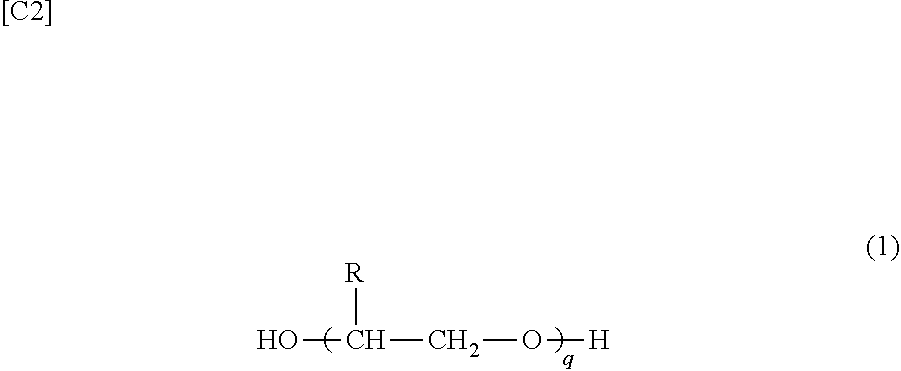Polycarbonate resin composition
a polycarbonate resin and composition technology, applied in the field of polycarbonate resin composition, can solve the problems of low brightness, polycarbonate resins are more likely to suffer from problems such as yellowing than pmma, and achieve excellent anti-static properties and surface appearance, improve transmittance and hue, and improve the effect of transmittance and yellowing degr
- Summary
- Abstract
- Description
- Claims
- Application Information
AI Technical Summary
Benefits of technology
Problems solved by technology
Method used
Image
Examples
production example 1
rbonate Copolymer (B11)
[0186]An amount corresponding to 75 mass % of “PTMG650” available from Mitsubishi Chemical Corporation (Mw: 1,950) as polytetramethylene glycol (hereinafter abbreviated to PTMG), an amount corresponding to 25 mass % of bisphenol A (hereinafter abbreviated to BPA) and diphenyl carbonate (hereinafter abbreviated to DPC) at a molar ratio of 1.05 relative to the amount of diol were added to a polymerization apparatus equipped with a 1 L five-mouthed flask. The pressure in the system was lowered to 0.13 kPaA or less, drying was carried out for 1 hour, and tetramethyl ammonium hydroxide (TMAH.5H2O) was then added as a catalyst at a quantity of 10,000 μmol relative to 1 mole of the diol. The pressure in the system was lowered to 0.13 kPaA or less, drying was carried out for 15 minutes so as to remove water derived from the catalyst, and the pressure inside the polymerization apparatus was then restored with nitrogen. At the point when the pressure-restored polymeriza...
production example 2
rbonate Copolymer (B12)
[0188]Polymerization was carried out in the same way as in Production Example 1, except that “PTMG1000” available from Mitsubishi Chemical Corporation (Mw: 3,450) was used as the PTMG and the heating / depressurization program shown in Table 1 was used.
[0189]The proportions by mass of a bisphenol A (BPA) constituent component and a polytetramethylene glycol (PTMG) constituent component in the obtained polycarbonate copolymer (B12) were 25 mass % of BPA and 75 mass % of PTMG, and the polycarbonate copolymer had a weight average molecular weight (Mw) of 10,300.
production example 3
rbonate Copolymer (B13)
[0190]Polymerization was carried out in the same way as in Production Example 1, except that “PTMG1500” available from Mitsubishi Chemical Corporation (Mw: 5,400) was used as the PTMG and the heating / depressurization program shown in Table 1 was used.
[0191]The proportions by mass of a bisphenol A (BPA) constituent component and a polytetramethylene glycol (PTMG) constituent component in the obtained polycarbonate copolymer (B13) were 25 mass % of BPA and 75 mass % of PTMG, and the polycarbonate copolymer had a weight average molecular weight (Mw) of 9,400.
PUM
| Property | Measurement | Unit |
|---|---|---|
| temperature | aaaaa | aaaaa |
| temperature | aaaaa | aaaaa |
| temperature | aaaaa | aaaaa |
Abstract
Description
Claims
Application Information
 Login to View More
Login to View More - R&D
- Intellectual Property
- Life Sciences
- Materials
- Tech Scout
- Unparalleled Data Quality
- Higher Quality Content
- 60% Fewer Hallucinations
Browse by: Latest US Patents, China's latest patents, Technical Efficacy Thesaurus, Application Domain, Technology Topic, Popular Technical Reports.
© 2025 PatSnap. All rights reserved.Legal|Privacy policy|Modern Slavery Act Transparency Statement|Sitemap|About US| Contact US: help@patsnap.com



